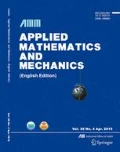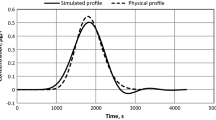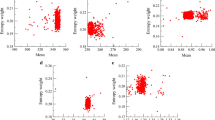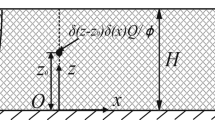Abstract
As a primary parameter in the water quality model for shallow bays, the dispersion coefficient is traditionally determined with a trial-and-error method, which is time-consuming and requires much experience. In this paper, based on the measured data of chemical oxygen demand (COD), the dispersion coefficient is calculated using an inversion method. In the process, the regularization method is applied to treat the ill-posedness, and an operator identity perturbation method is used to obtain the solution. Using the model with an inverted dispersion coefficient, the distributions of COD, inorganic nitrogen (IN), and inorganic phosphorus (IP) in Bohai Bay are predicted and compared with the measured data. The results indicate that the method is feasible and the inverted dispersion coefficient can be used to predict other pollutant distribution. This method may also be further extended to the inversion of other parameters in the water quality model.
Similar content being viewed by others
References
Fischer, H. B., List, E. J., Koh, C., Imberger, J., and Norman, B. Mixing in Inland and Coastal Waters, Academic Press, New York (1979)
Elder, J. W. The dispersion of a marked fluid in turbulent shear flow. J. Fluid Mech. 5(4), 544–560 (1959)
Fischer, H. B. Discussion of “simple method for predicting dispersion in stream” by R. S. Mc-Quivey and T. N. Keefer. J. Environ. Eng. Div., ASCE 101, 453–455 (1975)
Seo, I. W. and Cheong, T. S. Predicting longitudinal dispersion coefficient in natural streams. J. Hydraul. Eng. 124(1), 25–32 (1998)
Kashefipour, S. M. and Falconer, R. A. Longitudinal dispersion coefficients in natural channels. Water Research 36, 1596–1608 (2002)
Kuang, G. R., Chen, B. H., Qian, C. C., Yu, G. Y., Zhang, H., and Zhang, Q. A study on the calculation of horizontal dispersion coefficients in shallow sea water area (in Chinese). Transactions of Oceanology and Limnology 2, 1–8 (1992)
Kuang, G. R., Su, Z. Q., and Chen, B. H. Estimation of pollutant dispersion parameter for Chengbei sea-tidal current horizontal dispersion coefficient (in Chinese). Marine Environmental Science 12(2), 34–39 (1993)
Li, Y. L., Bian, Z. J., and Yu, C. Z. The theoretical analysis of pollutant dispersion in tidal flow and its application (in Chinese). Acta Mechanica Sinica 25(4), 394–403 (1993)
Li, Y. L., Bian, Z. J., and Yu, C. Z. The analysis and calculation of average dispersion in tidal flow (in Chinese). China Envirenmental Science 14(4), 252–258 (1994)
Heemink, A. W., Mouthaan, E. E. A., Roest, M. R. T., Vollebregt, E. A. H., Robaczewska, K. B., and Verlaan, M. Inverse 3D shallow water flow modelling of the continental shelf. Continental Shelf Research 22, 465–484 (2002)
Dehghan, M. and Tatari, M. Determination of a control parameter in a one-dimensional parabolic equation using the method of radial basis functions. Mathematical and Computer Modelling 44, 1160–1168 (2006)
Li, G. S., Cheng, J., Yao, D., Liu, H. L., and Liu, J. J. One-dimensional equilibrium model and source parameter determination for soil-column experiment. Applied Mathematics and Computation 190, 1365–1374 (2007)
Barber, R. W. and Volakos, N. P. Modelling depth-integrated pollution dispersion in the Gulf of Thermaikos using a Lagrangian particle technique. WIT Transaction on Ecology and the Environment 80, 173–184 (2005)
Gong, Z., Zhang, D. S., and Chen, Y. P. Research on the environment influence of land pollution sources on Lianyungang coastal area (in Chinese). The Ocean Engineering 20(4), 72–77 (2002)
Zhang, T. F. Computational Fluid Dynamics (in Chinese), Dalian University of Technology Press, Dalian, 272–276 (2007)
Su, C.W. The Numerical Method and Application of Partial Differential Equation Inverse Problem (in Chinese), Northwestern Polytechnical University Press, Xi’an, 20–33 (1995)
Kirsch, A. An Introduction to Mathematical Theory of Inverse Problems, Springer, New York (1996)
Falconer, R. A., Lin, B., Wu, Y., and Harries, E. DIVAST Model: Reference Manual, Environmental Water Management Research Centre, School of Fluid Mechanics, Cardiff University, U. K. (1999)
Ji, M., Sun, Z. W., Wang, Z. L., and Tao, J. H. A simulation experiment of the biodegradation process of COD from ocean outfall discharge in Bohai Bay (in Chinese). Oceanologia et Limnologia Sinica 30(6), 731–736 (1999)
Nie, H. T. and Tao, J. H. Impact of coastal exploitation on the eco-environment of Bohai Bay (in Chinese). The Ocean Engineering 26(3), 44–50 (2008)
Author information
Authors and Affiliations
Corresponding author
Additional information
(Communicated by Heng ZHOU)
Project supported by the National Natural Science Foundation of China (No. 10872144) and the Global Environmental Foundation (No. TF053183)
Rights and permissions
About this article
Cite this article
Nie, Ht., Tao, Jh. Inversion of dispersion coefficient in water quality model using optimal perturbation algorithm. Appl. Math. Mech.-Engl. Ed. 30, 703–712 (2009). https://doi.org/10.1007/s10483-009-0604-x
Received:
Revised:
Published:
Issue Date:
DOI: https://doi.org/10.1007/s10483-009-0604-x




